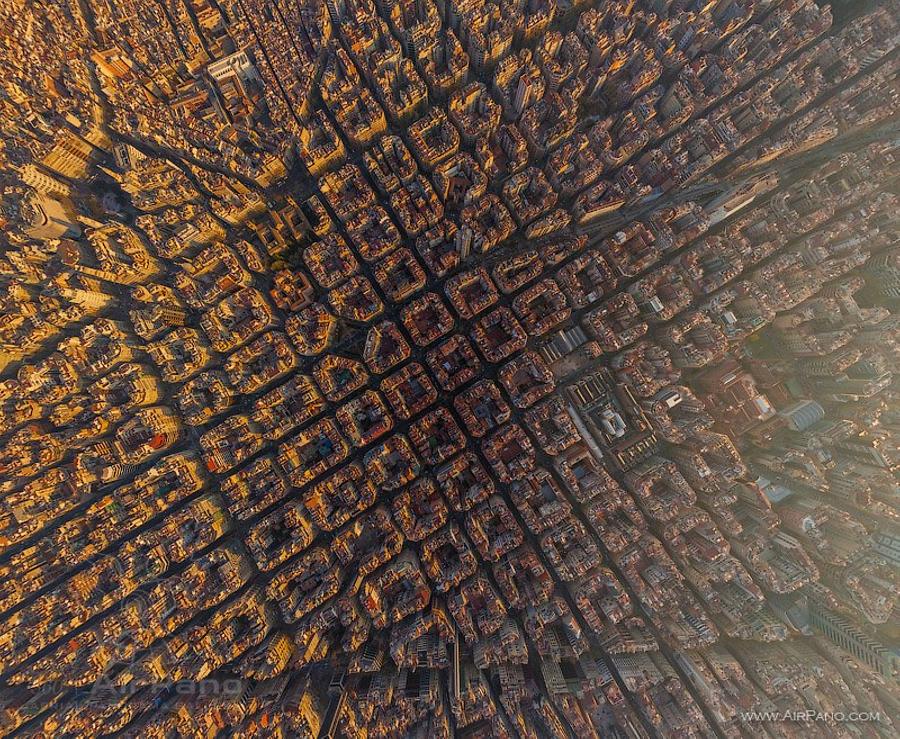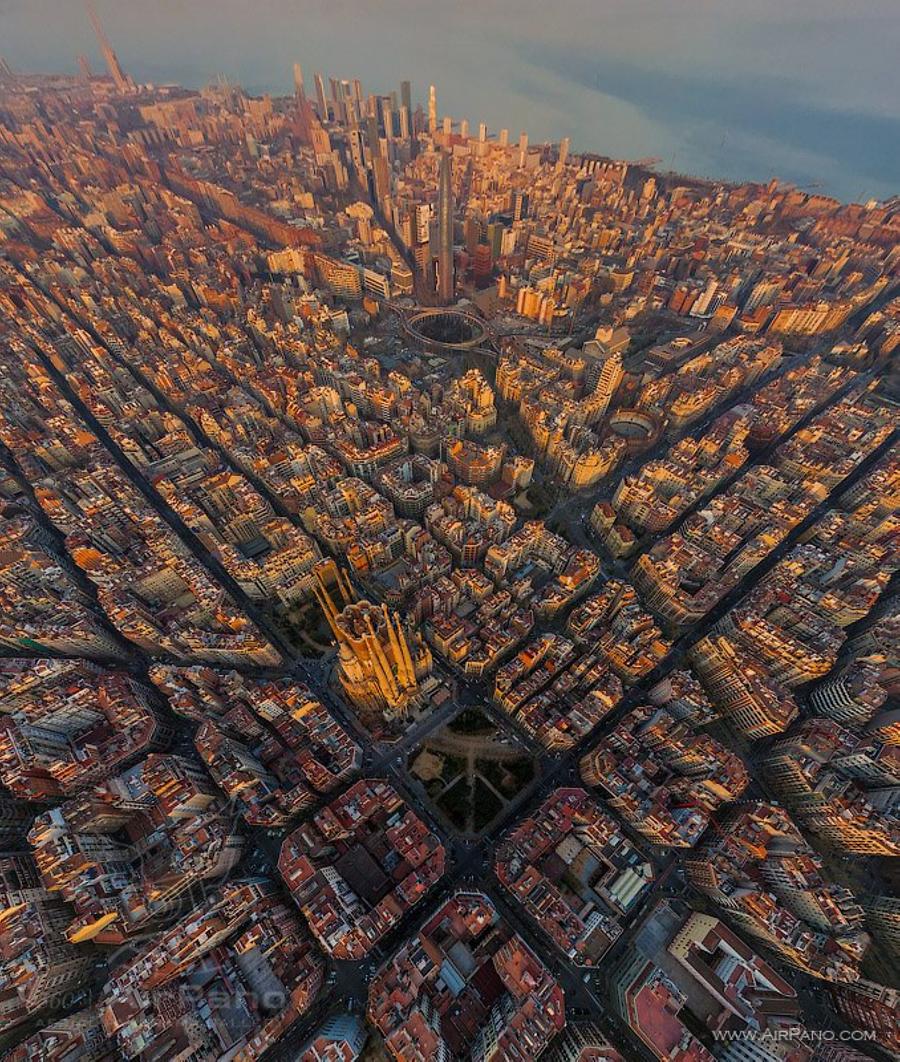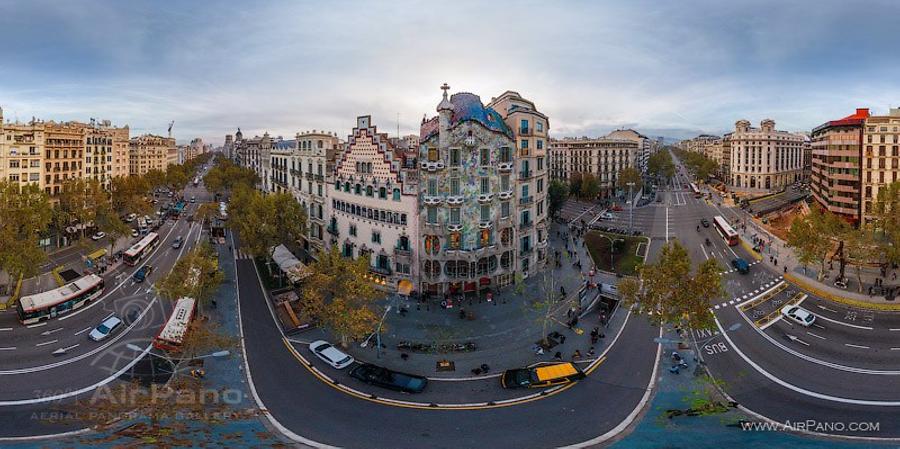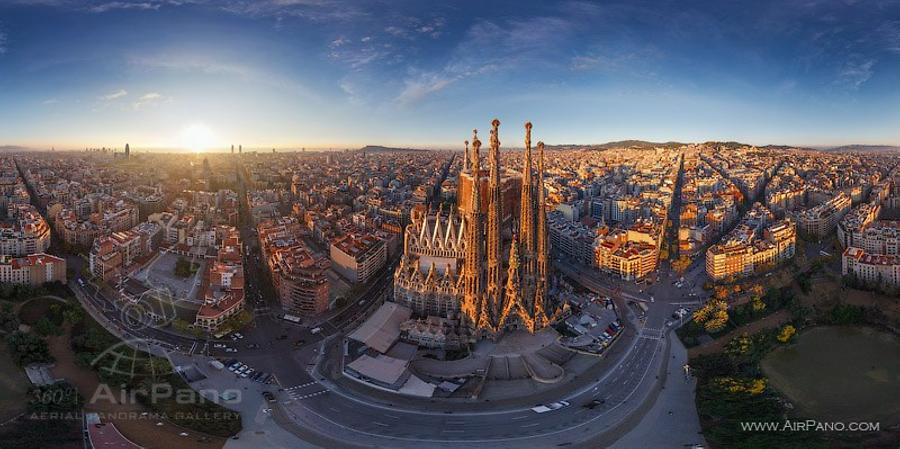Barcelona#
by Stanislav Sedov and Dmitry Moiseenko,
members of the AirPano Team that is a member of the global-geography Consortium.
5 April 2013
with kind permission of AirPano
Barcelona is one of the most famous ancient cities in the world. According to one of the legends, the city was founded by the Hercules, the legendary hero of Greek mythology, 400 years before Rome. The second legend attributes the foundation of Barcelona to Carthaginian Hamilcar Barca, father of the commander Hannibal.
Due to its ideal location on the Mediterranean coast, Barcelona was a thriving city that was repeatedly besieged and conquered by many nations, including the Romans, Visigoths, Moors, Franks, British, and other nations. Despite that, the city was able to preserve its heritage up to this day. Various Barcelona landmarks, from the ancient fortresses to ultramodern skyscrapers, encompass almost all periods of its history.

The center of the old city is the Gothic Quarter. It still has many structures that were built during the Middle Ages, and even some buildings that were built around the time of the first Roman settlements. Right next to the Gothic Quarter is La Rambla, a lively street that is a must-see for everyone planning a trip to Barcelona. Besides fine shops and restaurants, almost every building here is an architectural monument. Particularly interesting is the old Boqueria market which is constructed from glass and decorated with mosaics, as well as the 60-meter tall monument to Columbus. The monument stands exactly where the famous explorer landed from his first voyage to America.

The city itself consists of many hills that have different height. The highest point (500 meters above sea level) is Mount Tibidabo that offers picturesque views of Barcelona. The name of the mountain comes from the Latin «Tibi Dabo» («I give you»), the words of devil whispered to the God in order to tempt him while showing the beauty of the world from the top.
The second highest point (173 meters) is Montjuic mountain, where Barcelona hosted the World's Fair in 1929 and the Summer Olympic Games in 1992. Local places of interest include futuristic Magic Fountain in the form of ellipse with lighting, music, and sometimes fireworks. A little further to the top of the mountain, we can find Montjuïc Park and Olympic area, as well as Montjuic castle, one of the most famous historic buildings in Barcelona. It was built in the 17-18th centuries to defend the city. During the course of the history the castle was seized several times: by the British led by Count Peterborough and also by Napoleon's troops. Nowadays it houses a military museum.

At the foot of the mountain lies Plaza de España, one of the biggest squares in the city that was dedicated to the occasion of the 1929 World's Fair. There are two 47-meter tall Venetian Towers in front of the square and there is a gorgeous fountain decorated with Baroque style sculptures in the middle. Plaza de España in Barcelona serves as a symbol of the city's former greatness, and at the same time as a symbol of the modern city-state. It is a majestic symbol indeed!
Other great monuments of the 20th century include the Palace of Catalan Music, a fine example of Catalan modernist style, built by the architect Luis Domenech i Montaner, and the Agbar Tower, a modern 38-story skyscraper (though four of its floors are underground). The shape of the tower was inspired by water, spectacular shape of nearby Montserrat mountain, and by the bell towers of the Sagrada Familia in Barcelona. This whole structure is made of metal and colored glass panels.

But all Barcelona landmarks combined ??pale in comparison to great monuments designed by the architect Antoni Gaudí. Of course, every monument in Barcelona is unique, but each one of them can be attributed to a certain style. Baroque fountains, Venetian Towers, modern buildings, and ancient Roman ruins can be found in many other cities across the globe. Without some additional information it's hard to pin point if you see photos from Spain, Italy, or, perhaps, the Czech Republic? However, each architectural masterpiece by Gaudi isn't like anything else in the world. All you need is to see one of his buildings, balconies, or "swirls", and you can instantly identify his style among many others. There are several houses designed by Gaudi in other cities, but most of his legacy can be found in the capital of Catalonia.
There are millions of pages written about this amazing architect — the founder of his own style that was unique only to him — no words can convey the essence of Gaudi's unique masterpieces. Gaudí spent his childhood by the sea, so all of his homes resemble a sand castle. He thought that the sky and the sea make the best interior, and wood and clouds were perfect sculptural forms. Gaudi hated closed and regular-shaped spaces, avoided straight lines, and considered them man-made; whereas a circle was of divine origin. It's hard to describe the masterpieces created by the architect with such believes.
You should see for yourselves. Our panoramas will show you some of his masterpieces: Park Güell (1900-1914), Casa Milà (1906-1910), and the Sagrada Familia in Barcelona which is under construction for last 130 years.

In total there are dozens of structures created by Gauidi in the capital of Catalonia, and not all of them are buildings. For example, in Park Guell, which occupies an area of more than 17 hectares, there are numerous houses and fountains, paths and columns that were created by Gaudi's powerful imagination.
Let's have a more detailed look at Sagrada Familia. The Church of the Holy Family (or Sagrada Familia) is a church in Barcelona's Eixample district, the famous project of Antoni Gaudi, that has been under construction with private donations since 1882. Although Gaudi was just one of the architects, it was his contribution from 1883 to 1926 that defined the current look of the legendary church. And even despite the fact that in 2008 a group of more than 400 cultural workers of Spain demanded to stop the construction of the church (according to them, the great architectural masterpiece fell victim to careless and clumsy restoration catered mainly to tourism industry), its unusual appearance has made it one of the main tourist attractions in Barcelona. In November 2010 Pope Benedict XVI consecrated Sagrada Familia, so now it can officially hold church services. Even being under construction the church looks amazingly beautiful.
The administration of Barcelona kindly agreed to remove all cranes from the Sagrada Familia construction site during our photo session. If you would like to see this place with cranes, you can open panoram 22 in our virtual tours.

Since our panoramic views of Barcelona show you the city from a bird's eye view, it means that they reveal almost the whole city. You can choose any Barcelona landmark or historical period you're most interested in and zoom in. Enjoy your virtual excursion!